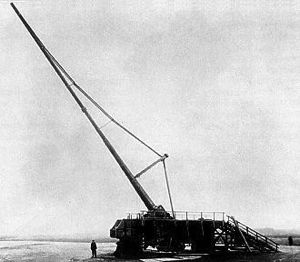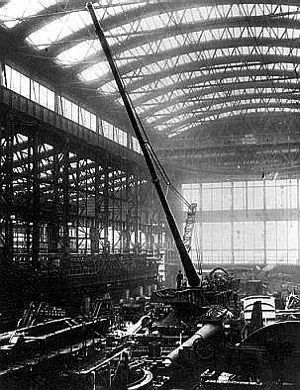
Home - Search - Browse - Alphabetic Index: 0- 1- 2- 3- 4- 5- 6- 7- 8- 9
A- B- C- D- E- F- G- H- I- J- K- L- M- N- O- P- Q- R- S- T- U- V- W- X- Y- Z
Paris Gun
 Paris Gun Deployed |
AKA: Kaiser Wilhelm Geschuetz. Status: Retired 1918. Payload: 120 kg (260 lb). Gross mass: 120 kg (260 lb). Diameter: 0.21 m (0.68 ft).
The Paris Gun of World War I (called by the Germans the Kaiser Wilhelm Gun and often incorrectly termed Lange Max or Big Bertha, two completely different guns) was the direct ancestor of the V-3. The rail-mounted weapon was 34 meters long and weighed 125 metric tons. Its 180 kg powder charge could hurl a 120 kg shell with 7 kg of explosive to a range of 131 km. During the 170 second trajectory the shell reached a maximum altitude at the edge of space - 40 km. This was the highest altitude attained by a man-made object until the first successful V-2 flight test on October 3, 1942. From March through August of 1918, three of the guns shot 351 shells at Paris from the woods of Crepy, killing 256 and wounding 620. As a military weapon the gun was a failure - the payload was minuscule, the barrel needed replacement after 65 shots, and the accuracy was only good enough for city-sized targets. But as a psychological tool it was remembered when the V-1, V-2 and V-3 weapons were being developed two decades later.
Seven 21-cm guns were made, using bored-out 38-cm naval guns fitted with special 40 m long inserted barrels. For most of the war there were only two mountings. After 65 shots the barrels were removed and re-bored to 24-cm caliber. At the end of the war one spare mounting was captured by American troops near Chateau-Thierry, but no gun was ever found.
Maximum range: 131 km (81 mi).
Family: Gun-launched. Country: Germany. Launch Sites: Peenemuende. Bibliography: 2, 47, 8475.
 | Paris Gun in Shop |
1918 March - . Launch Vehicle: Paris Gun.
- Paris Gun begins bombardment of Paris - .
Nation: Germany.
Apogee: 40 km (24 mi). Range: 131 km (81 mi).
The rail-mounted weapon could hurl a 120 kg shell with 7 kg of explosive to a range of 131 km. During the 170 second trajectory the shell reached a maximum altitude at the edge of space - 40 km. This was the highest altitude attained by a man-made object until the first successful V-2 flight. From March through August of 1918, three of the guns shot 351 shells at Paris from the woods of Crepy, killing 256 and wounding 620. As a military weapon the gun was a failure - the payload was minuscule, the barrel needed replacement after 65 shots, and the accuracy was only good enough for city-sized targets. But as a psychological tool it was remembered when the V-1, V-2 and V-3 weapons were being developed two decades later.
August 1936 - . Launch Site: Peenemuende. Launch Complex: Peenemuende. Launch Vehicle: Paris Gun.
- Ground broken at Peenemuende - .
Nation: Germany.
First objective is development of the A4 strategic ballistic missile, later dubbed the V-2. The missile is to deliver a one tonne high explosive payload to double the range of the Paris Gun of World War I (250 km - the Paris Gun could deliver a ten kg, 21 cm diameter shell to 125 km range). To provide a reserve, the missile was designed for a 1500 m/s burnout velocity, which resulted in a 275 km range. Accuracy was to be 2 to 3 per mille, versus typical artillery shell accuracy of 4 to 5 per mille. These requirements indicated a 25 tonne thrust engine, powering a 12 tonne missile, with a 2100 m/s exhaust velocity, burning 8 tonnes of propellant in 65 seconds. The requirement to transport the missile by rail limited the diameter to 1.6 m, which in turn led to a 14 m length. Span with the detachable tail fins was 3.5 m.
Several major issues had to be solved during development. The first was what wing and body shapes would be stable at supersonic velocities. Another was building adequate ground facilities for the intensive tests needed to develop the 25 tonne thrust motor. For this purpose a static test facility was built at Peenemuende capable of handling 100 tonne thrust motors, seen as the next step after the A4. Another major problem was developing high-capacity pumps to deliver the liquid oxygen at a temperature of -185 deg C.
Back to top of page
Home - Search - Browse - Alphabetic Index: 0- 1- 2- 3- 4- 5- 6- 7- 8- 9
A- B- C- D- E- F- G- H- I- J- K- L- M- N- O- P- Q- R- S- T- U- V- W- X- Y- Z
© 1997-2019 Mark Wade - Contact
© / Conditions for Use